After he was demobbed in 1946 my father, Mark Berryman applied to the Crown Agents for a position as Civil Engineer with PWD in Aden. In March 1947 we – Mark and Alice Berryman and 10year old daughter Ann, were on the troopship ‘Empire Ken’ sailing to Aden. Mother and I were in a six berth female cabin and I presume father was similarly accommodated in a male cabin. My only remembrance of the voyage were the ‘bum boats’ in Port Said and the ongoing lectures on board about the dangers of mosquitos and malaria. (In eight years in Aden I never saw or heard a mosquito or used a mosquito net).
The Government houses of this period were in Crater, other civilians lived in houses in Ma’alla. At this time there were only two blocks of flats in Ma’alla, I think one was for B.A.T. (British American Tobacco) staff. Our first home was a large and airy double storey house close to the Sultan’s Palace in Crater and overlooking Sira island. Coming from a London terraced-house this seemed like a palace with its large rooms, deep verandahs and black shiny tiled floors. The colour of these tiles seems strange but they deadened the glare from the bright sun outside although they must have been difficult to clean after a sandstorm. We were house-sitting for a family on long leave (Dr and Mrs Goodman) so we eventually had to move across the sand into a charming low rise house on various levels that had been the hospital in the 30s. (see photo) We had what was probably the only garden in Crater as in the hospital years soil had been brought from Sheikh Othman and planted with different coloured bougainvilleas and jasmine. The ‘mali’ made irrigation channels in the soil around each plant and kept them well watered.
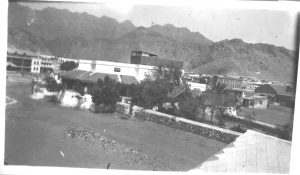
The interior features of these and the subsequent houses we lived in were similar. There were punkahs over the lounge and dining area and in the bedrooms. To a child the punkah over the bed was frightening as it rattled and shook and threatening to fall and decapitate you – or so I imagined. Airconditioning in bedrooms became available in the 50s but my mother refused it saying it was unhealthy.
The furniture was the same, the chairs and settees made of wooden slats with cushions covered with your own material from the bazaar. This could have unforeseen consequences as when my mother went to her first dinner party at Government House and found her newly-made dress perfectly matched the seat covers! In the early days the beds were the local charpoys made from rope on a wooden frame with a mattress on top, they were supposedly cooler than a conventional bed. The best part of the ‘hospital house’ was the covered sleeping verandah on the roof where you could lie and listen to the sounds from the bazaar and even hear the sea. Although there was electricity for lights and punkahs, cooking was done on a paraffin stove and the fridge ran on paraffin too.
Shopping for fresh food was done in the bazaar by mother and our bearer who accompanied her. Disgusting deep fried sheep’s brains and lady’s fingers were some of the results of shopping expeditions and it was only later I learned that lady’s fingers were not animal but vegetable – okra. All vegetables and fruit had to be washed before eating or cooking in purple potassium permanganate and meat, chicken or lamb (perhaps goat?), was washed in vinegar to take away any ‘off’ smells. All this changed when the cold storage depot was built in Ma’alla, I think in the early 50s, and a wider range of food was imported – including delicious tinned butter and cheese. Did we need so many servants to run these houses? The bearer was a superior fellow in his long whites with a red fez; was in charge of the other servants and waited at table. The cook had an assistant, there was an inside and outside sweeper (a cleaner); when we had a garden there was a mali, a chowkidar kept watch from dusk till dawn and when my sister was born we had a tall and stately Somali ayah to look after her who was clad in dazzling white flowing garments.
The emporiums of Bhicajee Cowasjee and Cowasjee Dinshaw in Tawahi had a selection of household goods and clothes and the English Chemist, run by Mr Rodrigues, stocked Elizabeth Arden cosmetics. But the best place to be whilst mother shopped was on the verandah of the Blue Bay Restaurant in the gardens under the watchful eye of Queen Victoria; here you could have a delicious watery ice-cream in a glass dish. There was a small dark shop like a museum where my father would take me to see two stuffed mermaids – dugongs – which I found horrid but fascinating My parents had a Hungarian friend in one of the Ma’alla flats called Dr Holub and when we children visited he took out his glass eye and put it into his pink gin. Children remember the more macabre events!
I went the Franciscan Convent in Steamer Point, it was a strange school as there was only one main room containing four different classes presided over by four severe nuns. As hard as I tried I could never become top of the class, my rival was Lourdes Courtinho, a pretty Indian girl, She was very clever and I wonder what her future held. We wore white dresses with an SFC embroidered in blue cross-stitch on the bodice.
There was a small room where I began piano lessons and any loud clock ticking now reminds me of the metronome that sat on the piano and Sister’s shouts when I couldn’t keep time. Piano lessons meant practising and as we had no piano at home I would spend one afternoon a week at the home of Padre and Mrs MacGuffie where I struggled to practice on their small organ. It was difficult enough to read and play the music as there were two large pedals to operate to get the organ going and a lever by the left knee whose function escapes me now. The best part of these visits was going to their flat in the back streets of Crater where I wasn’t normally allowed to go and eating Mrs MacG’s tiny meringues which she called ‘kisses’. In spite of these attractions I still cannot play the piano – or organ.
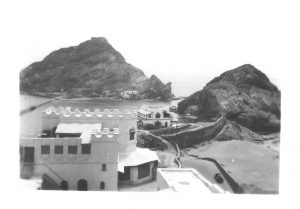
I had a school friend in these early days called Lynette, she lived in what looked like a castle (see photo) high on a hill in Crater looking down onto Sira, we went to the convent together, met up during later school holidays and again before we both left Aden to begin our adult lives. It was a carefree time time for us children, we could walk alone to Sira, past the Bottling Plant and climb to the fort (see photo). I wonder if the skeleton of a dog still lies in the moat. We rode polo ponies from the Khormaksar Club, sometimes along the beach and even in Sheikh Othman Gardens. On Sundays Lynette and I would go to a church service held by Padre MacGuffie at St Marys-on-the Hill in Crater – I don’t remember any church music. I have a New Testament given to me on my birthday in 1948 inscribed by Padre & Mrs. MacG.
The birthday party picture of 1947 (see photo) brings together some of my contemporaries – Noreen Lowes, Jocelyn Tring, Patience Floode-Cooke and Lynette Shrubbs, other names are long forgotten, maybe someone will put names to faces.
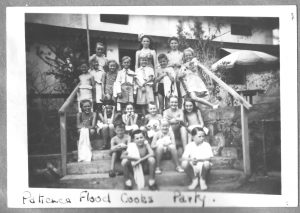
Much of my parents life revolved around the happenings at the Union Club and what was going on in the harbour. Being one of the busiest ports in the world the volume of shipping passing through was enormous and different vessels could be seen daily from the Club verandah. A highlight for 1947 was Navy week which was held in October when HMS Norfolk was in port. (see photos)’
Our third house was the nicest and my home for the summer holidays of 1952. It was known as Lake House, the old Residency set into a hill at
Tarshyne. I think Lake was a corruption of Loch who was the resident in the 1870s. The buildings rambled along the hillside and were almost completely covered by bougainvilleas and jasmine. The rooms had wooden lattice doors and windows, good for cooling the rooms but hopeless in a sandstorm. In 1952 the Brazilian Naval training ship ‘Almirante Saldanha’ called into Aden and hosted receptions for residents, this was a highlight of my holiday.Another naval ship we visited in the harbour was HMS Birmingham. Schooldays in England ended and I returned to Aden with the family after their long leave, on ‘SS Kenya’ of British India Line. What a change from the ‘Empire Ken’. This time it was first class travel and not only did the officers change from winter uniform into summer whites as we neared Port Said but the chairs covers on the furniture were changed too.
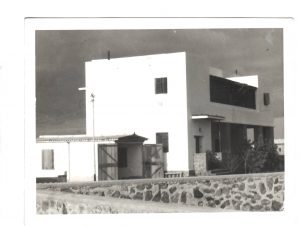
My last home in Aden was in one of the newly built houses in Khormaksar; two lines of houses surrounded by nothing – we were No.11, Downing Street. It was a large square white box, the rooms were high, large and airy. One problem was the water supply. Water was piped over ground from Sheikh Othman which meant when it reached the house it was hot, so in order to have a cool bath the water had to be run into the bath hours before it was required. This was our first house with a garage and during an early driving lesson I drove straight into the back of it.
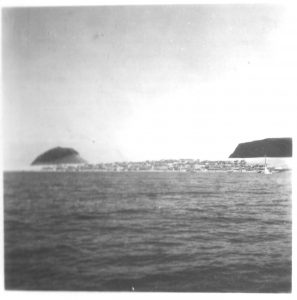
The Refinery at Little Aden was constructed during this period (1952-1954) and when the personnel were eventually housed we were invited to visit their club house; it was air conditioned and very modern compared with the Union Club and Goldmohur. The flare eventually became a landmark and from the beach at Goldmohur we could watch the oil tankers passing into the harbour, one of 80,000 tons stays in my memory as being the largest then seen in Aden!
Elsewhere on this website I have written of my working and fun days in the early 50s and I realise that nowhere have I mentioned the RAF. It is strange that the Forces and Civil ex-patriate communities led such separate lives. My only contact with the RAF came when I was asked to do a live Desert Island Discs programme for their radio station.
In 1956 the family moved to a house on a cliff near the lighthouse at Ras Marshag, my sister Mary said it had wonderful views over the sea. You could see this house on Google Earth but on the latest version it is now hidden under cloud. On Google Earth our Crater and Khormaksar houses are lost in a mass of buildings, but I fancy I can see the greenery of Lake House at Tarshyne.
I left Aden for the last time at the end of 1955 and spent the next 30years in Africa. I would love to return to Aden for a visit but am sure that I would not recognise the Aden that I knew and loved.
What a fascinating and interesting story!
Our family never lived in Aden (except when we were waiting for boats to carry us off somewhere). We lived across the way a bit in Somaliland: Sheikh, Boroma and Hargeisa, roughly mid 1954 to early 1958. We made a number of trips with Aden Airways, so there is a chance that we might have shared the same plane,
We also lived on Downing Street in Aden! But 1958/9. My sister and I went to the Isthmus school across the sand from our house which was the furthest corner one. My happiest childhood memories are of Aden. In particular I remember the hot bath water being run hours before we needed it!
I also lived in Downing street with my two sisters. My eldest sister went to boarding school in England and came to visit in the long summer holidays. I have many fond memories. Going to the beach. Learning to swim at a very early age. Making dens with my sisters in the gardens.